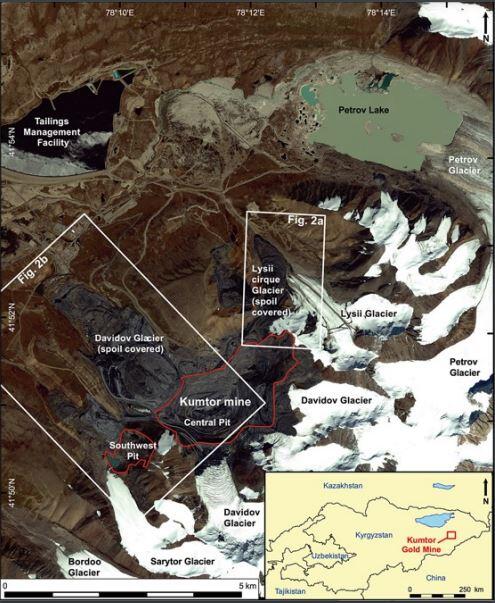The evolution of debris-covered glaciers formed by gold mining in Kyrgyzstan
This Master's project is available from the intake of autumn 2023. Please contact the listed supervisor for more information.
Main content
Project description
Motivation:
The evolution of debris-covered glaciers in response to climate change differs from that of climatically equivalent clean-ice glaciers because the englacial transport and deposition of rock debris sets up feedbacks between mass balance and ice flow (Rowan et al., 2015). Landslides move large volumes of debris onto glacier surfaces that then cause glaciers to advance rapidly and this forcing may be recorded by glacial geology (Vacco et al., 2010). Numerical modelling experiments can be used to explore the behaviour of debris-covered glaciers under a changing climate that could be difficult to interpret in the Quaternary geological record.
An interesting example from High Mountain Asia is the glaciers surrounding Kumtor Gold Mine in the Tien Shan mountains in Kyrgyzstan. These glaciers have become extreme examples of debris-covered glacier systems as the result of the dumping of huge volumes of mine waste onto the glacier surfaces in the last three decades (Evans et al., 2016; Jamieson et al., 2015). The glaciers have displayed surprising behaviours including rapid advances (i.e., surging) and the reactivation of Little Ice Age moraines, leading to the destruction of mining infrastructure. This area is therefore a good case study to explore how landsliding and the formation of thick debris layers affect the dynamic evolution and mass change of mountain glaciers over a range of time scales.
Research questions:
How to glaciers respond to a sudden input of rock debris, such as a large landslide? How is the glacial geological record affected by debris-covered glaciers? How hazardous are advancing glaciers, and how will the landscape continue to evolve around Kumtor Gold Mine?
Work plan and methods:
This project will combine a higher-order ice-dynamical glacier evolution model, iSOSIA (Egholm et al., 2012; Rowan et al., 2022) with surface mass balance modelling (Born et al., 2019) to make a series of experiments to explore the sensitivity of glaciers in the Tien Shan to a range of temporal and spatial distributions of supraglacial debris. The candidate will make model experiments to account for the different densities of ice and rock debris and consider the decoupling of the basal sediment between the permafrost and the glacier sole. Remote sensing data will be used to constrain and evaluate the model by observing changes in the structure of the glacier and the surface processes operating across the catchment over recent decades. Training will be given in each of the methods and enthusiasm to learn is more important than prior experience.
Proposed course plan during the master's degree (60 ECTS):
Høstsemester:
GEOV230 Glacial geology and geomorphology (10 sp)
GEOV324 Polar palaeoclimate (5 sp)
Vårsemester:
GEOV325 Glaciology (5 sp)
GEOV302 Data analysis in earth science (10 sp) GEOF211 Numerical Modelling (10 sp)
Felt- lab- og analysearbeid
The project will be desk-based using Linux-based high performance computing, Matlab, and GIS. Familiarity with these methods is useful but not essential, as training and ongoing support with model use and development will be part of the project. The candidate will also have the opporutnity to join ongoing field work projects to learn more about mountain glaciers if desired.
